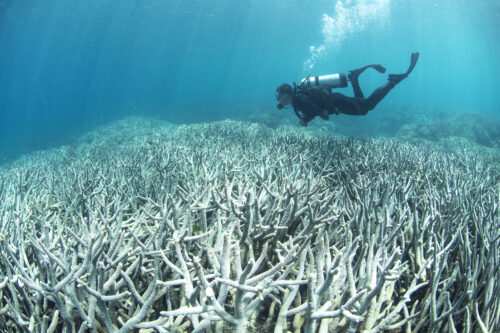Image courtesy of Flickr
In 2018, Hawaii banned the sale and distribution of sunscreen products containing oxybenzone and octinoxate due to their toxicity to coral reefs. In 2023, the ban was broadened to include avobenzone and octocrylene. These active ingredients are found in most chemical sunscreens, leaving few options for beach-goers. There is rising concern about the effects of chemical sunscreens on marine ecosystems, especially among popular ocean-side destinations. The U.S. Virgin Islands and Key West, Florida have taken similar measures to protect the biodiversity of their marine habitats.
Chemical sunscreens function by absorbing solar radiation with polymers called “UV filters.” However, these ingredients become harmful pollutants once they enter the ocean. They damage coral DNA and increase the risk of coral bleaching, which leaves the coral vulnerable to degradation and strips away its normal color. The active ingredients are also small enough to permeate the skin barrier and enter the bloodstream. Studies have reported that oxybenzone can disrupt sex hormone systems in humans and lead to developmental abnormalities in animal test subjects.
Hawaii now only allows the sale of mineral sunscreens, which are less toxic to the environment. Mineral sunscreens use particles of titanium dioxide or zinc oxide to physically reflect the sun’s rays. The FDA recognizes them as generally safe for humans since they are too large to pass through the skin membrane. However, they leave a pasty white layer on the skin and are more likely to cause acne breakouts, making them less desirable for consumers who are concerned with aesthetics. Until a replacement for the banned active ingredients is developed, though, they are the only option available for purchase in Hawaii.
A recently published investigation led by researchers from Tsinghua University in China developed a new active ingredient for chemical sunscreens: P(3). The team leveraged the Biginelli reaction, a synthetic technique that coordinates the simultaneous reaction of three molecules, to create compounds that resemble common active ingredients. They hoped to create a larger compound with similar UV filtering properties that would not be able to pass through the small pores in the skin membrane. After many attempts using the Biginelli reaction and another similar reaction, the team was finally successful in developing a suitable polymer. “We are quite lucky to finally find the conditions to get P(3),” said professor Lei Tao, supervisor of the study.
When tested on mice, P(3) offered significantly more UV protection compared to pure active ingredients and commercial sunscreen products. Furthermore, while coral and algae exposed to oxybenzone did not survive, P(3) had no harmful effect on them. P(3) does not penetrate further than the very outer layer of the skin and has unexpectedly low toxicity levels when injected into the bloodstream. A quick glance at the pictures of the bleached coral labeled “oxybenzone” next to healthy coral treated with P(3) reaffirms the potential impact of these findings.
Although the results from P(3) are promising, the research team is still searching for compounds that are biodegradable and easy to make. “We hope to find easier synthesis routes to prepare coral-friendly and environment-friendly anti-UV polymers with different structures,” Tao said. This discovery brings us a step closer to developing sunscreens that protect users from harmful UV radiation without harming the environment.

